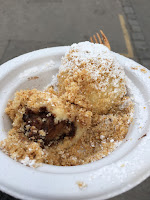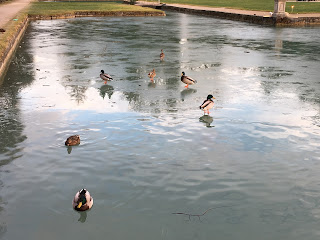It's well past 8pm when we arrive, the skies are dark and the air is brisk; although no where near as cold as it has been in other cities. Right now, it 's not even cold enough for snow. We wheel our bags along the quiet streets for about 15 - 20 mins and arrive at the Hotel Mozart. We are checked-in quickly by the hotel night manager, who takes us up to our room. He tells us that the room is in a primo location and mentions what a great view it has as he is leaving. We pull open the drapes to peer out the window into the night. It's an ok view we say as we discuss between ourselves - we're not really sure why he was singing its praises.
We snuggle into bed for an early night. While the sights have been amazing, we have now travelled through five cities and three countries and are feeling a little worn out.
The next morning, the sun peeks into the room between the gaps of the curtains. We slowly coerce ourselves out of bed, remembering that we haven't really made any plans for Salzburg and so should get a move on. We go over to the window, pull back the drapes and suddenly realise what the night manager has been talking about. Through the window, we almost have a full panoramic view of the city (or town as it feels more like) of Salzburg, as well as the mountains that overlook it. Not a particularly tall town, we are higher than most in our 5th floor room and are feeling much more excited about heading out than we did one panoramic view ago.
Being a little unplanned for this part of the trip, we decided to use the hop on hop off bus to get around to all the "must-see" tourist sites, while having our Rick Steves Audio Europe app as our personal guide at select attractions.
Hopping off the hop-on-hop-off bus as our first stop, we follow the directions on the map to arrive at Mozartplatz, or Mozart Square, where there is a statue honoring the composer who was born in Salzburg in 1756, just a few blocks from here.
We walk through (yet another!) Christmas Market, carefully mapping out the food stalls we will no doubt attack later, as we make our way to our next stop - the Salzburg Cathedral. The cathedral has an impressive dome which stands 70 meters high - that's almost 47 Tims stacked foot to head and the entrance is flanked by two additional domed towers. We enter the cathedral and like all other cathedrals we have visited thus far in Europe, we are in awe of the grandeur and size of the building - it is said to have housed some 5,000 worshipers when Pope John Paul II visited in 1998.
As we step further into the cathedral, Rick Steves guides us to a small baptismal font in the first chapel. Built in 1320 and surviving the initial destruction of the cathedral, a young Mozart was baptised here in 1756 and this church would become his home for the next 25 years.
Looking at the alter from the back of the church and looking up at the dome - no lights in here, all natural daylight.
We do a 360 as we stand at the front on the church. We are surrounded not only by the tombs of 10 archbishops from the 17th century, but more importantly, four organs. One or more of which was played by Mozart himself for two years when he served as an organist.
We exit the cathedral and decide to head up the hill to Festung Hohensalzburg, or Fortress Hohensalzburg, We take the time to walk up but for the cheaters, there is a funicular that will take you to the top of Europe's largest intact medieval fortress. The tracks of the funicular actually date back to the 1500s when it was operated manually and used for moving livestock and cargo up to the castle. Today's electric model also impressively dates back to 1910. The fortress has had and incredible history - building commenced in 1077 as a small castle. Over the centuries, it slowly grew into the fortress it is today and it did its job - so foreboding, no one dared attack Salzburg in nearly a thousand years, and the city has never been taken by force. They surrendered to Napoleon in the early 1800s and became a military barracks, before being opened to the public in the 1860s. Even during WWII, when much of Salzburg was destroyed by Allied bombers, the town and castle survived. According to Rick, Hohensalzburg Fortress remains one of Europe's mightiest castles, dominating the city's skyline.
View from Hohensalzburg Fortress
Next, it was time for some food so we hot foot it down the hill back to the Christmas Markets - and here are some pictures of food and Christmas market cheer!
 Bellies full, we headed over our next stop, St Peter's Monastery, Cemetery and Crypt. Currently a Benedictine monastery and former cathedral, St Peter's Abbey is considered "one of the oldest monasteries in the German-speaking area, and the oldest with a continuous history since its foundation in 696".
Bellies full, we headed over our next stop, St Peter's Monastery, Cemetery and Crypt. Currently a Benedictine monastery and former cathedral, St Peter's Abbey is considered "one of the oldest monasteries in the German-speaking area, and the oldest with a continuous history since its foundation in 696".The adjoining cemetery, dates back to 1627 and is the oldest Christian cemetery in Salzburg. It is a peaceful place scattered with mini gardens amongst headstones - some of which have had their owner's names completely worn off with time. In Austria, graves are rented for 10 year periods. If payment is not made after the 10th year, tombstones are removed and placed in the walls surrounding the cemetery. The cemetery also appears in the story of the von Trapp Family, or as we know it, The Sound of Music. Near the end of the movie, the family hide here in the cemetery as they make their escape - well, in the move it was a movie set inspired by the cemetery. The cemetery is the permanent home to some famous folks - the architect of the cathedral, placed so that his tombstone forever faces his creation (I sure hope he liked it); Mozart's sister, Nannerl, who performed with him on tours of Europe's palaces; and also the younger brother of Joseph Haydn, Michael, who was (as we were told by Rick Steves) a composer of great note himself, and who succeed Mozart as the church organist at the Salzburg Cathedral.
On the other side of the cemetery is a hillside, where hermit monks were meant to have lived. We pay a small fee to visit, but have to admit that there is not much of interest in the catacombs, though it allows some pretty views of the graveyard below.
L: View of the cemetery from a window in the catacombs; R: St Peter's and it's adjoining cemetery in the foreground
Making our way back to the bus stop, we come across the Waterwheel. It was interesting to look at but it wasn't until later that we realised that it was part of a canal system that brings water from the base of the alps some 10 miles away, all the way to Salzburg. It was built in the 13th century and is still in use today! When the stream source reached Salzburg, it split into five smaller canals providing fire protection and also powered factories into the 19th century (good use of green power!). And every Thursday, the water from the canals are used to flush the streets of Salzburg. It's good to note that Slazburg has never suffered from a plague.
Some poor photos of the waterwheel
Not sure what Tim is eating, but I've got them Mozartballs.
 Then it's back on the bus! Quick stop at Schloss Leopoldskron and Lake (Leopoldskron Palace) which provided the facade of the house in the Sound of Music house - remember that scene with the lake? It's now a hotel and the rates seem reasonable.
Then it's back on the bus! Quick stop at Schloss Leopoldskron and Lake (Leopoldskron Palace) which provided the facade of the house in the Sound of Music house - remember that scene with the lake? It's now a hotel and the rates seem reasonable.I should mention that on our bus, there was also an audio tour to point out famous landmarks as we drove along. You obviously got a choice of language and if you spoke English, you could choose to listen to some classical music while taking in the history of Salzburg. Or.... if you were a fan, you could switch to the Sound of Music channel to hear music from the movie and facts about the von Trapp family as well as some trivia from the movie.
 Our final stop for the day is Schloss Hellbrunn - or as you may have guessed by now, Hellbrunn Palace. Unfortunately, visiting in the winter season meant that the palace itself as well as the trick fountains in the gardens were not in operation. But, we hung around the Christmas Market and took a stroll around the grounds - watch out, more Sound of Music references up ahead!
Our final stop for the day is Schloss Hellbrunn - or as you may have guessed by now, Hellbrunn Palace. Unfortunately, visiting in the winter season meant that the palace itself as well as the trick fountains in the gardens were not in operation. But, we hung around the Christmas Market and took a stroll around the grounds - watch out, more Sound of Music references up ahead!
The trick fountains unfortunately "out of season"
L: The gazebo made famous in the Sound of Music with the song "Sixteen going on Seventeen"; R: Tim posing as usual.
We spent some time watching the ducks wandering on the half frozen lake.
Schloss Helbrunn at dusk with the mountains peaking over it.
Enjoying a hot meal at the end of a good day.





























No comments:
Post a Comment